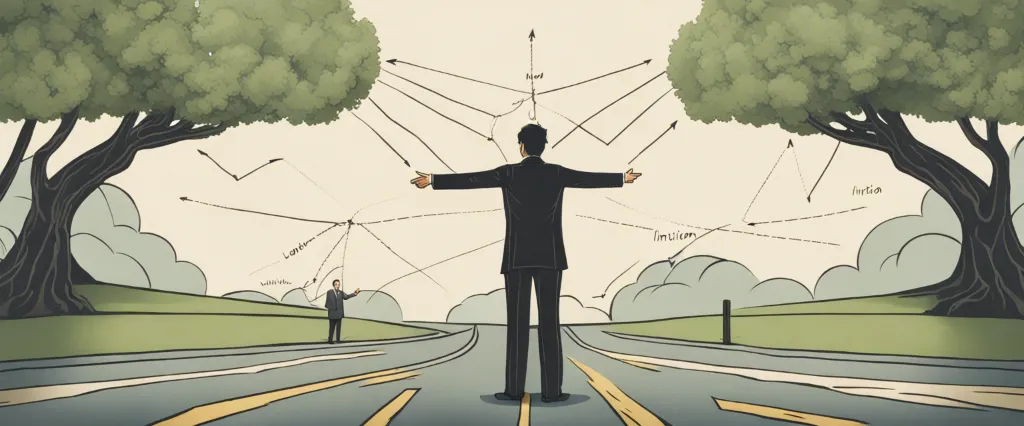
In “A Guide to the Good Life: The Ancient Art of Stoic Joy,” William B. Irvine explores the ancient philosophy of Stoicism and its practical application in modern life. Drawing from the teachings of the Stoic philosophers, Irvine presents a guide to achieving a life of tranquility, wisdom, and happiness. As a professor of philosophy at Wright State University, Irvine expertly weaves together historical anecdotes, philosophical insights, and personal accounts to elucidate the practicality and relevance of Stoicism today. By distilling complex ideas into accessible concepts, Irvine offers readers practical tools to navigate the challenges of daily life and cultivate a more fulfilling existence.
Chapter 1: The Philosophy of Stoicism
In Chapter 1 of “A Guide to the Good Life: The Ancient Art of Stoic Joy,” William B. Irvine introduces the philosophy of Stoicism. He begins by highlighting the origin of Stoicism in ancient Greece, with its most prominent figures being Zeno, Cleanthes, and Chrysippus. Irvine explains that Stoicism is not merely a system of belief, but rather a practical philosophy aimed at achieving a flourishing life.
Stoicism teaches individuals to live in harmony with nature, which involves recognizing and accepting things outside of our control. Irvine argues that our ability to control our judgments, desires, and actions is within our power, while external events are not. By focusing on what we can control, Stoicism helps us maintain tranquility and make the most of any situation.
The author also delves into the Stoic concept of virtue. Stoics believed that the only true good lies in the cultivation of excellent character, exemplified by the four cardinal virtues: wisdom, courage, justice, and self-discipline. By prioritizing these virtues, Stoics strive to achieve a virtuous and meaningful life.
Furthermore, Irvine emphasizes the Stoic approach to handling desires and aversions. Stoics advocate for differentiating between what is genuinely good or evil and what is merely preferred or avoided. By dispassionately evaluating our desires and realizing that external goods are not necessary for happiness, Stoicism helps individuals become more resilient and less reliant on external circumstances.
In conclusion, the philosophy of Stoicism, as explored in Chapter 1, provides a practical framework for living a flourishing life. By focusing on what we can control and cultivating virtues, the Stoics sought to attain tranquility and live in accordance with nature.
Chapter 2: The Dichotomy of Control
Chapter 2 of “A Guide to the Good Life” by William B. Irvine focuses on a philosophical concept known as “the dichotomy of control.” This concept explores the idea that there are certain aspects of our lives that are within our control, and others that are not.
Irvine begins by explaining how many people tend to worry about things that are beyond their control, such as the weather, the actions of others, or even life’s uncertainties. This tendency to fret over circumstances outside of our influence causes unnecessary stress and unhappiness. Therefore, the author argues that it is crucial to differentiate between what we can control and what we cannot.
According to Irvine, the only things we truly have control over are our own thoughts, beliefs, desires, actions, and intentions. He suggests that we should focus our energy on mastering and governing these internal aspects rather than worrying about external events that are uncontrollable.
The chapter continues to explore the Stoic precept that we should strive to direct our attention and efforts toward what we have the power to influence. By doing so, we can live with more tranquility and resilience, unburdened by the unnecessary frustrations caused by trying to control what is not in our hands.
Irvine also highlights the Stoic practice of negative visualization, which involves contemplating worst-case scenarios and preparing ourselves mentally for them. This exercise allows us to better accept and adapt to adverse situations, as we have mentally rehearsed our response in advance.
Overall, Chapter 2 emphasizes the importance of recognizing the dichotomy of control, directing our focus on what is within our sphere of influence, and practicing mental readiness for life’s uncertainties. It provides practical guidance to cultivate a more serene and contented life by embracing these Stoic principles.
Chapter 3: Desire and Aversion
Chapter 3: Desire and Aversion of the book “A Guide to the Good Life” by William B. Irvine explores the concepts of desire and aversion from a Stoic perspective. It delves into the Stoics’ understanding of these psychological experiences and how one can utilize them to live a more fulfilling and virtuous life.
Irvine begins by addressing the common perception that desire is necessary for a good life. He explains that desire often leads to dissatisfaction and suffering, as our desires are typically focused on external or uncontrollable factors. According to the Stoics, true happiness lies in cultivating desires that align with nature and reason, rather than chasing fleeting and materialistic wants.
The chapter then delves into the Stoic approach to aversion, which is the intense negative reaction we have towards unwanted experiences. The Stoics argue that aversion is often irrational and counterproductive since it amplifies our suffering. Instead, they advocate for accepting and embracing the challenges and setbacks we face as opportunities for growth and self-improvement, rather than resisting them.
Irvine discusses the Stoic practice of negative visualization, which involves contemplating the loss of things we cherish in order to appreciate and be grateful for what we have in the present moment. By recognizing the impermanence of things and developing a sense of detachment, we can decrease our desires and aversions, leading to a more content and tranquil existence.
In summary, Chapter 3 explores the Stoic principles regarding desire and aversion. It emphasizes the importance of cultivating rational desires aligned with nature, while also developing acceptance and embracing challenges rather than resisting or being averse to them. By applying these Stoic practices in our lives, we can find inner peace and live a more fulfilling and virtuous life.
Chapter 4: Negative Visualization

Chapter 4 of “A Guide to the Good Life” by William B. Irvine introduces the concept of negative visualization, a Stoic practice aimed at increasing one’s appreciation for life and preventing hedonic adaptation. The chapter explores how the ancient Stoics employed this technique to cultivate gratitude, minimize desires, and build resilience.
Negative visualization involves imagining the loss of the things and people we value in our lives. This exercise helps us to recognize the impermanence of all things and to appreciate them while we still have them. According to Irvine, this practice simultaneously serves two purposes: reducing our attachment to external things and preparing us to deal with future adversity.
By contemplating worst-case scenarios in our minds, we become less dependent on external circumstances for our well-being. This technique allows us to differentiate between our needs and desires, recognizing that most of our desires are merely preferences and not essential for our happiness. It also helps us develop resilience by mentally rehearsing potential misfortunes, enabling us to better cope with them when they actually occur.
Irvine provides numerous examples of negative visualization exercises, such as imagining the sudden loss of a loved one, the destruction of one’s possessions, or the decline of health. By considering such scenarios, individuals become more grateful for the present moment, fostering a sense of abundance rather than constant longing.
Ultimately, incorporating negative visualization into our daily lives can liberate us from the continuous pursuit of material wealth and fleeting pleasures. It allows us to find contentment in what we already have, leading to greater peace of mind and a more fulfilling existence.
Chapter 5: Stoic Mindfulness and Meditation
Chapter 5: Stoic Mindfulness and Meditation of “A Guide to the Good Life” by William B. Irvine, explores the Stoic practice of mindfulness and its role in living a fulfilling life. Irvine begins by explaining how the ancient Stoics viewed mindfulness as a way to heighten awareness and maintain control over one’s thoughts, emotions, and actions.
The chapter highlights the importance of distinguishing between the things that are within our control (such as our thoughts and actions) and those that are not (such as external circumstances or other people’s opinions). Stoics believe that by focusing on what we can control and accepting what we cannot, we can cultivate a deep sense of tranquility and peace of mind.
Irvine introduces various Stoic techniques for practicing mindfulness, including a form of meditation called the View from Above. This exercise involves imagining oneself from a higher vantage point, looking down upon the world and recognizing the insignificance of our daily worries and concerns. By adopting this perspective, we can detach ourselves from our immediate troubles and gain a broader, more objective outlook on life.
Additionally, the Stoics encourage us to regularly reflect upon our actions and thoughts through an evening meditation called the Stoic Reserve Clause. This practice involves reviewing our day and contemplating whether we acted virtuously while also acknowledging that we may have made mistakes due to our imperfect nature. By doing so, we can learn from our experiences and strive to improve our character and behavior over time.
Overall, Stoic mindfulness and meditation offer practical tools for developing emotional resilience, serenity, and moral virtue. Through the deliberate practice of mindfulness, Stoics aim to regain control over their minds, maintaining a tranquil and meaningful existence despite life’s unforeseen challenges.
Chapter 6: Stoic Ethics and Virtue
Chapter 6 of “A Guide to the Good Life” by William B. Irvine delves into the Stoic approach to ethics and the pursuit of virtue. The Stoics believed that our eudaimonia, or flourishing, can be attained through the cultivation of virtue and the development of a virtuous character.
The Stoics recognized four key virtues: wisdom, courage, justice, and self-control. They saw wisdom as the foundation of all virtues, as it helps us make rational and informed judgments. Courage involves the ability to face and overcome fear, while justice emphasizes treating others with fairness and benevolence. Self-control is the mastery over our own desires and emotions, enabling us to live in line with reason.
To develop virtue, the Stoics recommended certain practices. The practice of negative visualization involves imagining the worst-case scenarios to prepare ourselves mentally and appreciate what we have. By doing so, we become less attached to external outcomes and cultivate gratitude for what we currently possess.
Another practice is the discipline of desire, where we aim to align our desires with things that are within our control. This helps us avoid unnecessary frustration and unnecessary attachments.
Furthermore, the Stoics emphasized the importance of accepting events that are beyond our control, known as the discipline of action. By focusing our efforts on what we can control, we can minimize stress and frustration.
Lastly, the book discusses the idea of living in accordance with nature, which means living in accordance with reason. By utilizing reason to guide our actions and decisions, we align ourselves with the natural order of the universe.
In summary, Chapter 6 explores the Stoic virtues and provides practical techniques to cultivate virtue and live a flourishing life. By developing wisdom, courage, justice, and self-control, and implementing practices such as negative visualization, discipline of desire, and discipline of action, individuals can enhance their moral character and achieve eudaimonia.
Chapter 7: Stoic Resilience and Adversity
Chapter 7 of “A Guide to the Good Life” by William B. Irvine focuses on the Stoic philosophy of resilience in the face of adversity. The Stoics believed that adversities and challenges are an inherent part of life, and therefore, it is essential to develop a resilient mindset to navigate through them.
The chapter begins by highlighting the Stoic practice of negative visualization. This technique involves deliberately imagining and contemplating various adversities that could potentially happen. By mentally preparing for them, individuals become less affected by the actual occurrence, leading to increased resilience. Stoics believed that by regularly practicing negative visualization, individuals could develop a tempered and calm response during challenges.
Next, Irvine discusses the Stoic concept of Amor Fati, which translates to “love of fate.” This idea emphasizes accepting and embracing the challenges and setbacks that life presents us. Instead of resisting or resenting these difficulties, Stoics stressed the importance of seeing them as opportunities for growth and self-improvement. By practicing Amor Fati, individuals can reframe their perspective on adversities, finding meaning and purpose within them.
The chapter also explores the Stoic practice of voluntary discomfort, through which individuals purposely expose themselves to discomfort, hardship, and deprivation. By willingly subjecting themselves to challenging experiences, Stoics believed they could build resilience and learn to appreciate the simple pleasures in life.
In conclusion, Chapter 7 of “A Guide to the Good Life” delves into Stoic resilience and demonstrates how individuals can develop mental fortitude to confront and overcome adversities. Negative visualization, Amor Fati, and voluntary discomfort are Stoic practices discussed in this chapter that can help individuals build resilience and maintain a sense of calm and contentment amidst life’s challenges.

Chapter 8: Stoic Practices for Daily Life
Chapter 8 of “A Guide to the Good Life” by William B. Irvine, titled “Stoic Practices for Daily Life,” explores various techniques and exercises that Stoics employ to lead a more fulfilling and virtuous life.
The chapter begins by discussing the importance of regular self-reflection and how it can help to identify and correct any negative or destructive thoughts. Stoics advocate for engaging in “morning reflection” and “evening reflection” to assess one’s progress in practice and address any negative emotions or regrets. This practice not only helps to develop self-awareness but also allows one to improve and make amends where necessary.
Another important technique discussed in the chapter is “adaptive indifference.” This involves practicing indifference towards external events that are beyond one’s control, such as the weather or other people’s opinions. By accepting that these things are not within our power, Stoics emphasize focusing on what we can control: our own thoughts, attitudes, and actions.
The idea of “negative visualization” is also introduced, which involves contemplating the loss of the things we possess and appreciate in our lives. This exercise helps us appreciate and value these things more deeply while also preparing ourselves mentally and emotionally for potential future losses.
The chapter further discusses the “view from above” technique, where individuals imagine themselves observing their lives from an external perspective, detached from personal biases and desires. This practice helps to gain a broader view of situations, enabling a more rational and objective assessment.
Furthermore, Irvine introduces the concept of practicing adversity, where stoics purposefully seek out discomfort and challenges in order to build resilience and reinforce their Stoic principles. These challenges can range from fasting, sleeping on the floor, or even engaging in public speaking.
In summary, Chapter 8 of “A Guide to the Good Life” elaborates on several Stoic practices aimed at living a virtuous and fulfilling life. By incorporating self-reflection, adaptive indifference, negative visualization, the view from above, and practicing adversity, individuals can strengthen their character, develop resilience, and maintain a more balanced and fulfilling approach to life.
After Reading
In conclusion, “A Guide to the Good Life” by William B. Irvine is a thought-provoking and practical book that offers a fresh perspective on the ancient philosophy of Stoicism. Irvine’s clear and accessible writing style, along with his incorporation of modern examples, provides readers with a comprehensive guide to applying the principles of Stoicism in their daily lives. By emphasizing the importance of focusing on what is within our control and adopting a philosophical mindset, Irvine presents a compelling argument for how Stoicism can lead to a more fulfilling and virtuous life. Whether one is seeking personal tranquility, resilience in the face of adversity, or guidance on finding purpose and meaning, this book serves as an invaluable resource for individuals seeking a practical philosophy to navigate life’s challenges. Overall, “A Guide to the Good Life” is a captivating and inspiring read that encourages readers to examine their beliefs and habits, ultimately empowering them to lead a more fulfilling and tranquil existence.
1. Man’s Search for Meaning” by Viktor E. Frankl: This powerful book explores the author’s personal experiences as a Holocaust survivor and his psychological perspective on finding meaning in life. It offers profound insights into human nature and the pursuit of purpose.
2. Sapiens: A Brief History of Humankind” by Yuval Noah Harari: Combining history, biology, and anthropology, Harari provides a thought-provoking account of the history of humanity. This book explores the impact of major milestones like the agricultural revolution and the cognitive revolution, shedding light on our species’ journey.
3. The Alchemist” by Paulo Coelho: An enchanting tale of self-discovery and personal legend, this novel follows the journey of a young shepherd in search of his dreams. It imparts timeless wisdom about perseverance, destiny, and following one’s heart’s desires.
4. Quiet: The Power of Introverts in a World That Can’t Stop Talking” by Susan Cain: Cain’s book challenges the notion that extroversion is superior to introversion. It explores the strengths that introverts possess and highlights the cultural bias towards extroversion. This insightful read advocates for valuing quiet and introspective individuals.
5. The Power of Now” by Eckhart Tolle: With a focus on living in the present moment, Tolle offers practical insights and exercises to help individuals attain spiritual enlightenment and find inner peace. This transformative book encourages readers to let go of past regrets and future worries, emphasizing the importance of living each moment fully.



